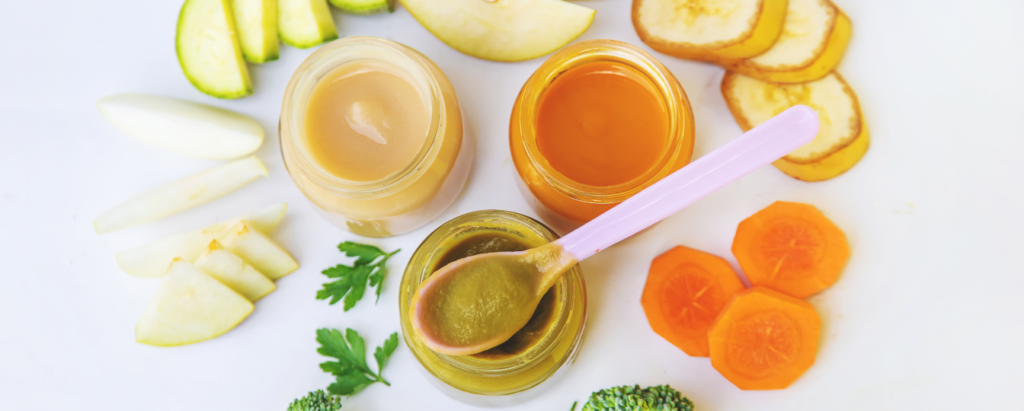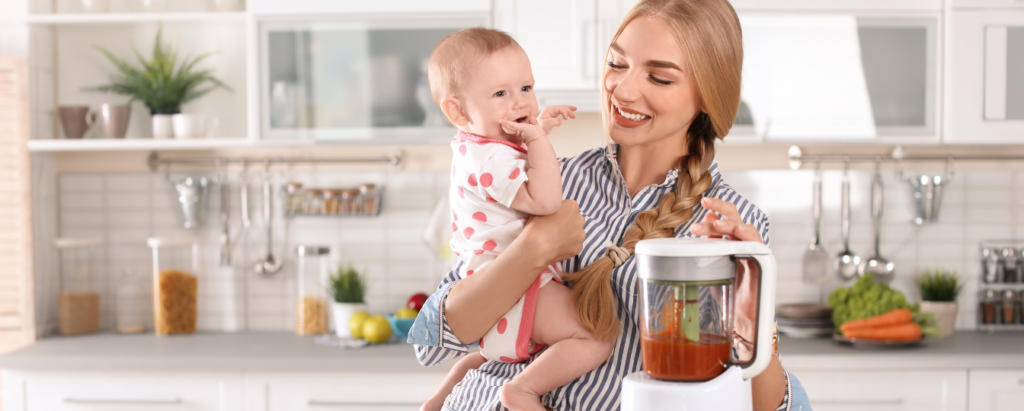If you’re a fan of cooking for yourself, why not try cooking something up for your baby as well? While it might not be a plated masterpiece, making your own baby food can be fun for you and nutritious for your baby. See what to whip up in the kitchen with tips on what to consider beforehand, which tools will be helpful in the kitchen, and what ingredients to introduce to your baby’s growing palate!
Things to Consider Before Making Baby Food
Making homemade baby food is a great way to get involved in the kitchen and know what your baby is eating! It’s also a great way to get to try new foods and introduce your baby to some new eating experiences. But before you start making some yummy purées, you’ll want to consider four main things:
Age to Switch to Solids
Is your baby old enough to move on to solids? Around the 6-month mark, transitioning your baby over to solid food is a huge baby milestone. While “solid” here doesn’t mean apple slices or raw carrots, it does mean you can start exploring the world of baby food purées that are safe for their gums and are choking hazards.
Baby Food Allergies
About 3% of infants are allergic to at least one food, so when you’re making baby food at home, it’s important to monitor how they are reacting when exploring this new world of food. When introducing new ingredients, keep your eye out for food allergy symptoms such as coughing, hives, or stomach issues.

Ingredients in Baby Food
Once you’ve determined your baby is old enough for baby food and you’re ready to look out for allergies, the next step is choosing your ingredients. There are a number of combinations you can do, but always be sure to buy high-quality, nutritious products and wash ingredients thoroughly before using.
Food Portions
Remember, your little one is, well, little! When they get started with solid foods, they might only eat 1-2 teaspoons of food a day and work their way up to 1-2 tablespoons. By 8 months, they might be eating 8 tablespoons a day, which is still a small amount. Prepare to make small batches or store in the freezer.
Homemade Baby Food Tips
Helpful Equipment
Before you get started, you’ll want to check your kitchen for all the essential tools to make homemade baby food. Everything can be done pretty simply with a few key pieces of equipment. The most important piece is something to make purées with. You can use a food processor, a blender, a potato masher, or a specialized baby food maker.
Some of these tools might get the job done faster than others, but as long as you can make the food soft and baby-friendly, you should be able to start. If using something like a potato masher or fork to mash the softened foods, running it through a fine mesh sieve can help you remove any larger chunks and make it a thinner consistency.
Other kitchen tools that may help the process are a steamer to soften tough produce, baking trays for any mass baking needs like toasting grains or cooking veggies, and stackable baby food containers that you can easily store and reuse. Of course, you’ll want to make sure all of your equipment, tools, and cooking surfaces are properly cleaned as well.

Baby Food Recipes
Grains, fruits, vegetables, and proteins are all some wonderful ingredients to add to your homemade baby food! It all comes down to preparation and flavors your baby likes. If your baby is new to switching to solids, you’ll want to add enough liquid to have it as a thin consistency, but older babies can start to consume thicker baby food as they become more used to it.
Be sure to remove things like skin, pits, and fat when prepping your ingredients. You’ll also want to avoid spices at the start, and don’t mix in honey until your baby is over one year old. You’ll also want to steam almost all produce when starting baby food to ensure everything is cooked and tender, even if you are blending the ingredients.
If you’re looking for some simple, healthy baby food recipes to get started, try these out, using water or breast milk to thin out each purée to your preferred consistency:
- 1 avocado, 1 banana
- 1 sweet potato, .5 cup steamed broccoli
- 1 steamed peeled apple, 1 steamed peach
- .25 cup steamed blueberries, .5 cup steamed carrots
Get creative with the combos! And while a puréed chicken or fish meal might not sound great to you, adding protein to your homemade baby food can add even more nutrition. You can also do simple purées of one vegetable or fruit blended with water or breast milk. This is a great way to see your baby’s preferences, especially at the start, and monitor for potential food allergies.
If you are transitioning to solid food, away from store-bought, or just want a fun, new way to connect with your baby in the kitchen, learning how to make homemade baby food can be a fun activity. Get your equipment ready, visit the grocery store, turn on that steamer, and get ready for a new culinary experience that involves a lot of mashed bananas and sweet potatoes!



